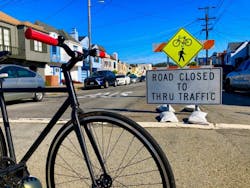SFMTA’s data-driven transportation recovery
The San Francisco Municipal Transportation Agency (SFMTA) is using data to guide not only its reaction to the COVID-19 crisis but also how the agency will recover.
Transit’s recovery
When shelter-in-place began and the SFMTA was forced to reduce Muni service, it identified how to focus service reductions using data. The Muni Core Service Plan prioritized available resources based on locations of medical facilities, Muni’s Equity Strategy and data from shifting customer travel patterns observed during the first weeks of the COVID-19 shelter-in-place order. The service plan kept all of San Francisco within one mile of an active Muni stop. As additional resources have become available, guided by the same data as well as additional information from operators, riders and city leaders, SFMTA has increased frequency and returned some additional routes to service.
As more people return to working in retail and manufacturing, there will be an increased demand for transit, even as physical distancing still limits Muni’s capacity. If SFMTA cannot get the thousands of employees who rely on Muni to work, San Francisco cannot recover economically, says the agency.
Preventing crowding and having everyone wear masks is key to recovery. Generally, as the activities allowed by the public health order expand, SFMTA is keeping the core service routes and increasing capacity and frequency. The increased frequency helps limit crowding and promote physical distancing.
As congestion increases with more movement, SFMTA also needs to use data to help identify solutions that keep buses from being stuck in traffic. With fewer cars on the road, San Francisco’s shelter-in-place simulates the street conditions across the city that are normally seen only on routes with transit lanes. On average, peak Muni travel times have been reduced by about 15 percent across the Core Service network during the shelter-in-place period. These time savings will inform how SFMTA can use transit priority improvements, like transit-only lanes, as it expands Muni service in a way that better serves customers and supports economic recovery.
When buses are stuck in traffic, it decreases the frequency that buses pick people up at stops. With less frequent pickups, more people gather at stops, making it harder to move all the people that need to board buses while maintaining physical distancing. When buses complete their trips faster, they can return to service more quickly to reduce crowding and support distancing. Deploying transit-only lanes could also enable Muni to reduce customer’s travel times and help reduce agency costs in the face of lost revenue and budget cuts.
Data-driving dedicated space for biking
With Muni being reserved for essential trips only, walking and bicycling have become more important than ever during this pandemic. Streets that are calm and welcoming support newer bike riders, helping to reduce demand for Muni trips. SFMTA is using public feedback and pre-existing data to implement Slow Streets traffic calming program that support walking and biking opportunities.
SFMTA staff gathered suggestions from conversations with members of the board of supervisors and community groups about locations for Slow Streets. They analyzed these inputs along with the 1,800 responses to the online, multilingual survey to identify the most frequently used corridors. Streets were then screened for topography, surrounding land use, conflicts with Muni service, primary public safety routes and commercial loading zones.
When fully implemented, there may be more than 34 miles of Slow Streets in San Francisco. SFMTA will analyze the effectiveness of the program by tracking the share of people driving, walking or biking on the street changes before and after implementation. Staff are also tracking side streets to see if there is substantial diversion of traffic.
As SFMTA moves forward towards recovery, it says it expects bicycling to continue to serve trips that would otherwise be made on Muni or create traffic congestion in a private automobile. The bicycle trip counters in some locations like the Panhandle path have shown massive increases. To be responsive and help provide more space for safer more comfortable riding, SFMTA is planning to add a protected bike lane on Fell Street. SFMTA will continue improving San Francisco streets through the data-informed approach to Vision Zero, build-out previously approved protected bike lanes and expand bike-share to provide access in more neighborhoods.
